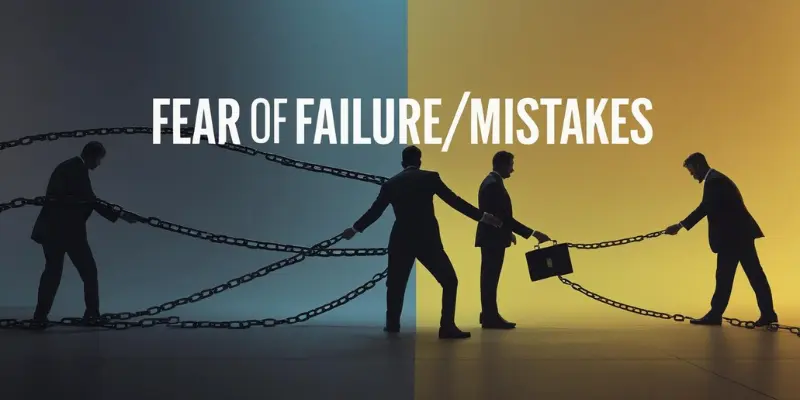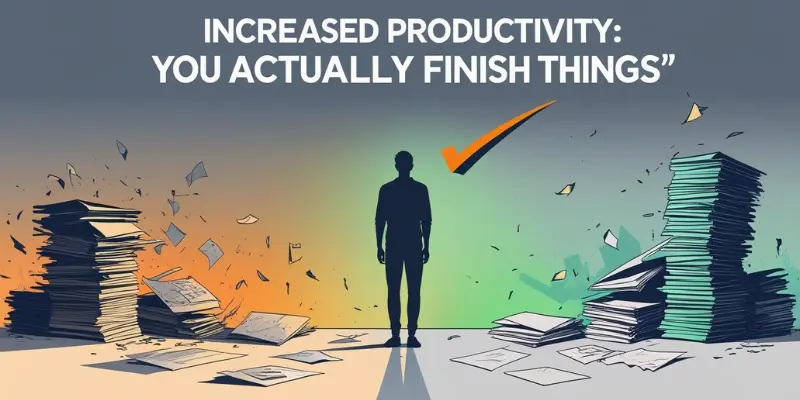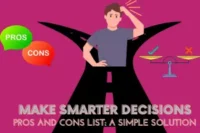The “Done is Better Than Perfect” Mindset: How to Overcome Analysis Paralysis
Published: 26/07/2025
Have you ever found yourself staring at a blank page, unable to get started on a project because the idea of it not being “perfect” holds you back? Or maybe you’ve spent hours, days, or even weeks tweaking something, only to realize you’ve made no real progress. That overwhelming feeling of being stuck, paralyzed by the endless search for perfection, is all too common.
I vividly remember a time when I couldn’t bring myself to finish a simple blog post. I kept overthinking every sentence, worrying if it would be engaging enough, informative enough, or even “perfect.” Days passed, and my ideas just sat there, collecting dust, while I searched for the elusive “perfect” version of the post. The more I obsessed, the less I achieved. That’s analysis paralysis.
At its core, analysis paralysis is the state of overthinking a decision or task to the point where you’re unable to take action. It’s that endless loop of weighing pros and cons, second-guessing yourself, and ultimately, doing nothing at all. Whether it’s choosing the right career path, starting a new hobby, or simply making a decision about your day-to-day life, analysis paralysis holds us hostage in a constant state of indecision.
The toll of staying stuck goes beyond the immediate frustration. There’s the emotional strain—stress, anxiety, frustration, and that nagging feeling of “I should be doing more.” And then, the practical costs—the missed opportunities, delayed goals, and the growing sense of regret. You feel like you’re wasting time, but the more you struggle to find the “perfect” solution, the farther away you move from real progress.
What if there was a way to break free from this cycle? A way to stop letting perfectionism rule your every move and instead, embrace progress over perfection? The solution is simple yet powerful: “Done is Better Than Perfect” (DIBTP).
This isn’t about settling for subpar work. It’s about realizing that progress—even imperfect progress—is far more valuable than waiting for perfection that may never come. The DIBTP mindset empowers you to take action, move forward, and learn along the way, without getting bogged down by endless revisions and self-doubt.
What You’ll Learn
In this post, you’ll not only understand the concept of DIBTP, but you’ll also discover practical strategies to apply it in your life. Whether it’s in your personal projects, career, or even day-to-day decisions, you’ll learn how to break free from perfectionism, reduce your stress, and boost your productivity. By the end, you’ll have actionable steps to begin making progress today—no more waiting for the “perfect” moment.
With this introduction, we’ve set the stage for addressing analysis paralysis and introducing the solution of the DIBTP mindset. It connects directly with the audience’s struggle, providing both empathy and a clear, actionable solution. Ready to move on to the next section?
Understanding Analysis Paralysis: Why We Get Stuck
Have you ever experienced that feeling where the more you think about a decision, the less sure you are about what to do? Maybe it’s the smallest decision—like choosing a new pair of shoes or drafting an email—that somehow spirals into an overwhelming task. Or, perhaps it’s a bigger, life-changing choice, like selecting a career path or deciding where to live. No matter the size, analysis paralysis is something that everyone can relate to at some point.
The truth is, there are specific psychological factors behind why we get stuck in these moments. Understanding them is the first step toward overcoming this mental roadblock.
The Psychology Behind the Stall
Let’s break down some of the core reasons why we fall into analysis paralysis:
1. Fear of Failure/Mistakes
For many overthinkers, the fear of failure is the root cause of their indecision. They hold off on making a choice because they fear the consequences of getting it wrong. What if the project fails? What if it doesn’t live up to expectations? This fear can feel paralyzing, especially when the stakes feel high.

Example:
Imagine you’ve been offered a new job, but you can’t decide whether to take it. The fear of failing in a new role—of not living up to the company’s expectations or your own—can prevent you from making a decision at all. Instead of taking action, you keep weighing the pros and cons, endlessly, until the opportunity slips away or you continue in your current, unsatisfying job.
2. Overwhelm by Choice
When faced with too many options, decision fatigue sets in. The mind becomes overloaded, making it harder to make any choice at all. This is especially true in today’s world where we have endless options—be it picking a vacation spot, choosing between multiple career paths, or deciding what to eat for dinner.
Example:
Think about planning a vacation. You start by looking for destinations, but suddenly, there are so many options—beach resorts, hiking trips, cultural city breaks—that you feel too overwhelmed to choose any. The result? You do nothing, even though you’ve spent hours researching.
3. Perfectionism’s Trap
Perfectionism isn’t just about wanting to do things well; it’s about expecting the absolute best outcome every time. When you demand perfection, you never feel ready to take action. There’s always a reason to make one more change, refine one more detail, or tweak something just a bit more. This constant pursuit of flawlessness can leave you stuck, waiting for the “perfect” moment that may never come.
Example:
Imagine you’re writing a blog post or creating a presentation. You’ve been working on it for days, but each time you look at it, something feels off. The font isn’t perfect, the wording isn’t exactly right, and you’re endlessly tweaking the visuals. Yet, in reality, you’ve spent hours working on something that’s already “good enough”—but the perfectionism trap keeps you from finishing it.
While it might seem noble to strive for absolute perfection, for many, it becomes a paralyzing force. The relentless pursuit of flawlessness often hides a deeper, more insidious self-doubt. As renowned author Julia Cameron wisely puts it:
Perfectionism is not a quest for the best. It is a pursuit of the worst in ourselves, the part that tells us that nothing we do will ever be good enough.Julia Cameron, Author of The Artist’s Way
This highlights the core truth: true perfectionism isn’t about achieving excellence, but about the fear of not being good enough. It keeps us stuck in a loop of endless tweaking and analysis, preventing us from ever releasing our work or moving forward.
4. Fear of Judgment
Another significant barrier to action is the fear of judgment. You worry about how others will perceive your decisions or work. What will your boss think? What will your friends or family say? This fear can cause you to second-guess every move you make, leaving you paralyzed and avoiding any decision that might invite criticism.
Example:
You’re preparing to post something on social media or submit a project, but you keep re-reading it over and over, thinking, “What if people judge me?” The fear of negative feedback keeps you from taking that first step. So, you hesitate. The post never gets published, and the project remains incomplete.
5. Information Overload
In the age of endless data and constant connectivity, information overload is a major culprit in analysis paralysis. We live in a world where we have access to an infinite amount of information—research articles, videos, blog posts, reviews—and it can be exhausting trying to sift through it all. The more you learn, the more you feel you need to know, and soon, you’re stuck in a cycle of never feeling prepared enough to make a decision.

Example:
Think about choosing the right laptop. You start by researching online, reading review after review, comparing specs, and watching YouTube videos. After hours of research, you feel even more confused than before. The overload of information has made the decision-making process even more difficult, and now, you’re too overwhelmed to pick anything at all.
Understanding the psychological factors behind analysis paralysis helps us see that it’s not about laziness or lack of effort—it’s a mental block rooted in fear, overwhelm, and perfectionism. The next step? Breaking free from these barriers, and learning how to take action despite them.
Now that we’ve identified why we get stuck, let’s dive into a mindset shift that can help you move forward—the “Done is Better Than Perfect” (DIBTP) mindset.
The ‘Done is Better Than Perfect’ Mindset: A Liberating Philosophy
It’s easy to believe that the pursuit of perfection leads to excellence. After all, shouldn’t we aim for the highest standard in everything we do? But here’s the truth: perfectionism often leads to inaction, frustration, and burnout. The key to breaking free from this cycle? Adopting the “Done is Better Than Perfect” (DIBTP) mindset.
This mindset isn’t about settling for mediocrity—it’s about embracing progress over perfection. It’s about shifting your focus from an unattainable ideal to real, tangible steps that lead you forward. Here’s what DIBTP really means.
What “Done is Better Than Perfect” Really Means
DIBTP is a mindset that encourages you to prioritize action, even if it’s not flawless. Instead of waiting for the perfect moment, it empowers you to take small steps, learn from them, and adjust as you go.
It’s Not About Sloppy Work; It’s About Progress Over Paralysis
The DIBTP mindset isn’t an excuse for producing low-quality work. It’s not about rushing or doing something carelessly. Rather, it’s about shifting focus from the ideal outcome to the action itself.
Imagine trying to build a house. You wouldn’t start by obsessing over the roof. You’d begin with the foundation, and then you’d build, piece by piece. At each stage, you’d evaluate your progress, make improvements, and keep moving forward. The key is to start with something real—something you can build upon—and not let the pursuit of a perfect finish stop you from getting started.
It’s About Iteration, Not Initial Flawlessness
Waiting for everything to be perfect before releasing it is like holding onto an idea forever, never sharing it because you’re afraid it’s not good enough. Instead, DIBTP focuses on iterating. The first draft doesn’t have to be perfect—it’s about getting something out there, receiving feedback, and improving from there.
Think about the development of software. The first release is never the final product. A company launches a minimum viable product (MVP)—it’s functional but not perfect. Then, they gather feedback, fix bugs, and iterate, improving the product over time. The goal isn’t to launch perfection; it’s to launch progress and refine from there.
It Prioritizes Momentum and Learning Over Stagnant Perfection
The DIBTP mindset centers on momentum—on making progress, no matter how small, rather than waiting for the “perfect moment.” If you spend too much time worrying about making something flawless, you risk never finishing. DIBTP teaches you that starting is far more important than waiting until everything aligns perfectly.
By making progress, even in small steps, you allow yourself to learn, adapt, and improve. In fact, learning comes from doing, not from obsessing over hypothetical scenarios or perfecting the details before taking action.
The Benefits of Embracing DIBTP
When you embrace the “Done is Better Than Perfect” philosophy, you unlock a series of powerful benefits that can completely transform the way you approach tasks, projects, and life in general.
Increased Productivity: You Actually Finish Things
One of the biggest obstacles that perfectionists face is finishing tasks. The endless pursuit of flawlessness often leads to unfinished projects and goals. DIBTP encourages you to finish—even if it’s not perfect. This shift in mindset means you’re actually completing tasks, rather than getting stuck in the never-ending cycle of tweaking and revising.

Example:
You’ve started a blog but haven’t published it because it’s never “perfect.” With DIBTP, you would publish that first draft. Sure, it may have a few rough edges, but it’s out there, and now you can focus on improving it over time.
Reduced Stress & Anxiety: Less Pressure to Be Flawless
Perfectionism places an enormous amount of pressure on you. The constant self-imposed expectation of perfection causes unnecessary stress and anxiety. With DIBTP, you let go of the need to get everything exactly right from the start, and that weight lifts off your shoulders. You can be more relaxed knowing that your work is good enough for now, and there’s room to improve later.
Example:
Instead of stressing over every tiny detail of a presentation, you focus on delivering the content effectively. As long as the core message is communicated, you can always tweak it after the initial presentation.
Faster Learning & Feedback Loops: Getting Something Out There Allows You to Learn and Improve
When you wait for the perfect product, you delay learning opportunities. By putting something out there—even if it’s not flawless—you can gather feedback and learn faster. Each iteration teaches you something new, helping you improve in ways that a perfect but unpublished product never could.
Example:
If you’re creating a website, you can start with a simple layout and test it with real users. You’ll quickly see what works and what doesn’t, allowing you to make informed improvements. Waiting for everything to be perfect means losing valuable learning experiences.
More Opportunities: Taking Action Opens Doors That Inaction Keeps Closed
By choosing progress over perfection, you open yourself up to more opportunities. Every action you take creates new possibilities—connections, experiences, and growth. Inaction, on the other hand, leaves opportunities unexplored and potential untapped.
Example:
Launching your business or career, even if it’s imperfect, opens doors to partnerships, clients, and personal growth. Staying in the planning phase out of fear keeps you stuck with missed chances.
Enhanced Confidence: Seeing Progress Builds Self-Belief
Each step forward, no matter how small, builds your confidence. The more you embrace DIBTP, the more you realize that progress—however imperfect—is better than stagnation. You begin to believe in your ability to accomplish things, which boosts your confidence in both your work and yourself.
Example:
As you tackle tasks and projects with DIBTP, you begin to see that completion leads to progress, which strengthens your belief in your abilities. Each “done” project, even if it’s not flawless, reinforces that you can move forward and improve along the way.
The DIBTP mindset isn’t about lowering standards; it’s about shifting the focus from impossible perfection to tangible progress. By embracing DIBTP, you’ll see a dramatic increase in your productivity, experience less stress, learn faster, open more doors, and build the confidence to keep pushing forward. It’s time to stop waiting for perfection and start moving forward—one step at a time.
Ready to learn how to implement these principles in your own life? Let’s dive into actionable strategies for overcoming analysis paralysis and embracing the DIBTP mindset.
Actionable Strategies: How to Implement DIBTP and Beat Analysis Paralysis
Now that we understand the “Done is Better Than Perfect” (DIBTP) mindset, it’s time to put it into practice. The goal of DIBTP is to help you take action, overcome indecision, and keep moving forward, no matter what. Here are some actionable, step-by-step strategies you can use to break free from analysis paralysis and embrace progress over perfection.
Set Clear, Achievable Boundaries
Creating boundaries around decision-making reduces the mental clutter and forces you to make quicker, more confident choices. By setting a time limit, you’re committing to action and freeing yourself from the trap of perfectionism.
1. Timeboxing Decisions: Give Yourself X Minutes/Hours to Decide, Then Move On
One of the easiest ways to break the cycle of overthinking is to timebox your decisions. Set a timer and give yourself a fixed amount of time to make a decision, then move on. The pressure of the countdown helps you avoid endless rumination and forces you to act.
Example:
If you’re struggling to pick a color for a design project, set a 10-minute timer. In that time, review the options, make a choice, and move on. This simple tactic can also be applied to tasks like deciding what to have for dinner or choosing which task to tackle first.
2. Limiting Options: Consciously Reduce Choices from the Outset
Too many choices can lead to decision fatigue. The more options you have, the harder it becomes to decide. Limiting your choices from the beginning can help you avoid feeling overwhelmed.
Example:
When buying a new phone, narrow your options to 2-3 models that meet your criteria. Instead of comparing every phone on the market, focus on the ones that fit your needs the best. This makes the decision easier and faster.
3. The “Good Enough” Standard: Define What “Done” Truly Looks Like, Not “Perfect”
Perfectionists often get stuck because they can’t define what “done” actually means. To beat this, set a “good enough” standard for yourself. Be clear about what “done” looks like, so you stop waiting for unattainable perfection.
Example:
When working on a report, your “done” could be “I’ve covered all the key points and checked for spelling errors.” Once this is done, stop—don’t get caught up in trying to perfect every sentence.
Break Down Overwhelming Tasks
When tasks feel too big or complex, it’s easy to get stuck. Breaking them into smaller, actionable steps removes the pressure and makes it easier to focus on the next immediate move rather than the entire project.
1. The “Smallest Next Step” Method: Identify the Absolute Tiniest Action to Start
Breaking large tasks into tiny steps makes them more manageable. The key is to focus on the smallest possible action to take the first step. This reduces the intimidation factor and helps you gain momentum.

Example:
If writing a book feels overwhelming, your smallest step might be “write 50 words today.” Don’t think about the entire book—just focus on writing those 50 words. Once you get started, momentum will carry you forward.
2. Iterative Milestones: Focus on Getting to the Next “Done” Point, Not the Final “Perfect” One
Instead of worrying about the perfect end result, focus on small milestones. Set incremental goals that lead you to the next “done” point. Celebrate these smaller wins to keep yourself motivated.
Example:
Planning a vacation? Instead of stressing about booking everything at once, focus on small steps. The first milestone might be “research three hotels.” Once that’s done, move on to the next step—booking the hotel.
3. “Eat That Frog” Principle (Modified for Perfectionists): Tackle the Intimidating Task First, But Only Aim for “Done,” Not “Perfectly Done”
The “Eat That Frog” principle encourages tackling the hardest task first. For perfectionists, this means doing it with the goal of just finishing, not making it perfect.
Example:
If you dread writing an important email, do it first thing in the morning. Just write it, send it, and don’t worry about it being perfect. The goal is to get it out there and take the next step, not agonize over every word.
Cultivate an Action-Oriented Mindset
To build momentum, it’s important to shift your focus from perfection to action. By embracing a mindset that prioritizes progress, you empower yourself to move forward with the work that’s already good enough to share or launch.
1. “The 70% Rule”: If It’s 70% Ready, Launch/Share/Submit
The 70% Rule encourages you to stop waiting for 100% perfection. If your project, idea, or product is 70% ready, go ahead and share it. The last 30% often doesn’t add as much value and can delay progress.
Example:
Let’s say you’re launching a blog. Don’t wait for your first post to be perfect—publish it when you feel it’s 70% ready. You can always tweak it later based on feedback.
Now that we understand the ‘Done is Better Than Perfect’ mindset, how do we actually put it into practice? The key lies in shifting from endless deliberation to decisive action. As the legendary Bruce Lee famously stated:
If you spend too much time thinking about a thing, you’ll never get it done.Bruce Lee
This simple, powerful truth cuts straight to the heart of analysis paralysis. It reminds us that no amount of planning or strategizing can replace the act of doing.
2. Embrace Imperfection as a Feature: View Early Drafts or Prototypes as Opportunities for Learning, Not Failures
Early drafts or prototypes are not failures—they’re stepping stones to improvement. Embrace the imperfections in your early work, as they are valuable learning experiences.
Example:
Launching a new app or product? Consider the first version as a prototype. Gather feedback, fix issues, and improve it as you go. The first version doesn’t have to be flawless—it just needs to be out there.
3. Pre-Commitment & Accountability: Tell Someone Your Deadline or Goal to Create External Pressure
Accountability can help you stay on track. By telling someone about your goals, you create external pressure to deliver. This can help you avoid procrastination and act when you otherwise might delay.
Example:
If you’re struggling to finish a project, tell a colleague or friend that you’ll have it ready by a specific date. The added accountability can help push you to meet the deadline.
Manage Your Inner Critic
Your inner critic can be a powerful force, often preventing you from taking action. By confronting your fears directly, you gain control over them and stop them from holding you back.
1. Externalize Your Doubts: Write Down Your Fears to Confront Them
Your inner critic often thrives in silence, amplifying doubts and fears. To combat this, write down what you’re afraid of. Externalizing your fears allows you to confront them head-on, rather than letting them control your actions.
Exercise:
Take a moment and write down all the things you fear about a project or decision. Once you see them on paper, you can start addressing each one and realize that many of your fears aren’t as big as they seem.
2. Challenge “All-or-Nothing” Thinking: Recognize the False Dichotomy of Perfect vs. Worthless
Perfectionists often see things in black and white—either it’s perfect or it’s worthless. Challenge this mindset by reminding yourself that progress is the goal, and any action, even imperfect, moves you forward.
Exercise:
Next time you think, “If it’s not perfect, it’s worthless,” reframe the thought: “Even if it’s not perfect, it’s progress.” This small shift can dramatically reduce the pressure you place on yourself.
3. Practice Self-Compassion: Be as Kind to Yourself as You Would Be to a Friend
The way you talk to yourself matters. Instead of harsh self-criticism, practice self-compassion. Treat yourself with the same kindness and understanding you would offer a friend going through the same thing.
Exercise:
When you feel yourself slipping into perfectionist thoughts, pause and ask, “What would I say to a friend who was feeling this way?” Then, say those same kind words to yourself.
Implementing the DIBTP mindset is about taking action—no matter how imperfect the process may seem. By setting clear boundaries, breaking tasks into manageable steps, cultivating an action-oriented mindset, and managing your inner critic, you can overcome analysis paralysis and start making real progress today. Each step you take brings you closer to your goal, and every “done” moment is a victory over perfectionism.
Expert Tips & Common Pitfalls to Avoid
By now, you understand the value of the “Done is Better Than Perfect” mindset and the actionable steps to implement it. But the journey to overcoming analysis paralysis isn’t always smooth. In this section, we’ll dive deeper into expert tips that ensure lasting change, as well as common mistakes that often keep people stuck. By learning from both, you’ll be able to move forward more effectively and avoid potential setbacks.
Expert Tips for Lasting Change
To make lasting changes, it’s essential to shift your approach to tasks. By reframing them as opportunities for growth rather than high-pressure situations, you can reduce fear and build confidence over time.
1. The Power of Small Experiments: Treat Tasks as Low-Stakes Tests
One of the best ways to remove the pressure of perfectionism is by treating tasks as small experiments rather than final products. Approach each task as a learning opportunity, where the outcome doesn’t have to be perfect. This perspective makes taking action less daunting and keeps you focused on the process rather than the result.
Example:
Instead of attempting to write the “perfect” blog post in one sitting, consider it an experiment where you test out your writing style, tone, or structure. If it doesn’t work as planned, you’ve learned something valuable, and the next time, you’ll know how to improve.
Expert Insight:
Psychologist Dr. Carol Dweck, in her research on growth mindset, emphasizes that people who see challenges as experiments tend to perform better over time. They’re more likely to take risks, learn from failure, and continuously improve.
2. Feedback Loops as Growth: Actively Seek Input on “Done” Work to Improve
Don’t wait for your work to be perfect before sharing it with others. Instead, adopt the mindset of feedback loops—getting input from others early and often so you can improve along the way. This not only helps you grow but also gives you confidence that you’re moving in the right direction.
Example:
If you’re working on a presentation, share your draft with a trusted colleague or mentor. Incorporating their feedback early will help you avoid perfectionist traps and make meaningful improvements before finalizing it.
3. Celebrate “Done”: Acknowledge and Reward Yourself for Completing Tasks, No Matter How Small
Often, the sense of accomplishment is overlooked in the rush to move on to the next task. But celebrating each “done” moment, no matter how small, can reinforce positive behavior and build your motivation to keep going.
Example:
After finishing a task, whether it’s as small as answering emails or as big as finishing a project, take a moment to celebrate. It could be something as simple as giving yourself a break, treating yourself to something small, or acknowledging your effort in a journal.
Expert Insight:
Behavioral psychologist Dr. B.J. Fogg, in his book “Tiny Habits,” recommends that you celebrate small wins to create lasting habits. By acknowledging progress, you train your brain to associate positive emotions with completing tasks, which boosts motivation and encourages you to keep going.
4. Mindfulness for Overthinking: Simple Techniques to Bring Awareness to Ruminating Thoughts
When you catch yourself spiraling into overthinking, mindfulness can be a powerful tool to bring you back to the present moment. Simple techniques like deep breathing, body scanning, or focusing on the sensations of your surroundings can ground you and reduce the intensity of rumination.
Exercise:
Take a few minutes to breathe deeply and focus on your body—what you feel, hear, or see around you. This technique interrupts the cycle of overthinking, helping you regain clarity and focus on taking action.
Common Mistakes That Keep You Paralyzed
While the DIBTP mindset can be incredibly liberating, there are still common mistakes many people make that keep them stuck. Understanding these pitfalls will help you avoid them and keep your progress on track.
1. Waiting for the “Right Time”: There Is No Perfect Moment
One of the biggest obstacles to action is the belief that you need to wait for the “right time”—whether it’s waiting for better circumstances, more information, or when you feel more “ready.” The truth is, there’s never a perfect moment. The best time to start is now.
Red Flag Scenario:
You’ve been putting off launching your online store because you’re waiting for the “perfect website design.” You keep tweaking it, but months pass by, and the store never launches. The right time was when you had something good enough to start with, not when everything was flawless.
2. Endless Research Without Action: Consuming Information Endlessly Without Applying It
In today’s world, it’s easy to get caught in the trap of endless research. We consume more information than ever before, but without applying it, it’s just a distraction. The key to beating analysis paralysis is action—even if it’s imperfect.
Red Flag Scenario:
You’ve been researching the best marketing strategies for your business for weeks but haven’t implemented any of them yet. You feel you need to gather more information before taking action, but meanwhile, you’re just stuck in an endless loop of research.
3. Comparing Yourself to Others’ “Final Products”: Only Seeing Their Polished Outcome, Not Their Messy Process
It’s easy to compare your unfinished work to someone else’s final product, especially with social media and public platforms showing only the polished end results. Remember, what you see is the result of their own imperfect journey.
Red Flag Scenario:
You compare your first draft of a novel to a published bestseller. Instead of seeing that the successful author went through countless revisions and drafts, you feel discouraged and paralyzed, thinking that your work isn’t “good enough.”
4. Confusing Busyness with Progress: Doing Many Small, Unimportant Tasks to Avoid the Big, Impactful One
This is a classic trap for perfectionists and overthinkers: filling your day with small, low-priority tasks to avoid tackling the bigger, more challenging ones. While staying busy feels productive, it can be a way of avoiding the important work that moves you closer to your goals.
Red Flag Scenario:
You spend the entire day organizing your email inbox or cleaning your desk, but the main task—writing that important proposal or starting your project—remains untouched. You feel productive, but you’re avoiding the real work that leads to progress.
The journey to overcoming analysis paralysis and embracing the DIBTP mindset is not always easy, but by following these expert tips and being mindful of common pitfalls, you can make lasting change. Small experiments, seeking feedback, celebrating progress, and practicing mindfulness will all help you build momentum and move beyond perfectionism. Be wary of waiting for the “perfect” moment, getting stuck in endless research, or comparing yourself to others—these behaviors only keep you stuck. The key is to take action, no matter how imperfect it may be. Keep moving forward, and the results will follow.
Ready to take the next step and implement these strategies in your life? Let’s continue the journey toward overcoming perfectionism and embracing progress!
Your Journey Towards Action: Next Steps
You’ve learned the ins and outs of the “Done is Better Than Perfect” (DIBTP) mindset. Now it’s time to take action. This section will guide you on how to start small, stay consistent, and take those first vital steps toward progress. You have everything you need to beat analysis paralysis and embrace a more productive, fulfilling life.
Start Small, Start Now
The hardest part of any project is often just getting started. You might feel overwhelmed by the size of your goals or the fear of not doing things perfectly. But here’s the truth: progress begins with the smallest of steps. You don’t need to wait for everything to be aligned before taking that first action.
Start with one tiny step. It doesn’t have to be perfect; it just has to be done. The important thing is to get the ball rolling.
Example:
If you’ve been avoiding starting a fitness routine because you think you need a perfect plan, just put on your workout clothes and walk for 5 minutes. That’s it. Once you’ve done it, you’ve already made progress. The next time, you might jog for 10 minutes, and before you know it, you’ve built a consistent habit.
The key is action—no matter how small. Starting now is more important than waiting for the “perfect moment.”
Build a Habit of “Done”
Consistency is the secret to success. Once you start, aim to make “done” your new habit. The more you practice completing tasks—even if they aren’t perfect—the easier it becomes. Soon, you’ll begin to see that progress, however small, is far more valuable than getting stuck in the endless pursuit of perfection.
Action Tip:
Set aside specific times each day to work on something. Whether it’s writing, exercising, or learning a new skill, commit to doing one thing each day—even if it’s for just 10 minutes. The key is doing it regularly, not perfectly.
Over time, this consistent action will become ingrained as a habit, and the fear of imperfection will fade away. You’ll be amazed at how much you can accomplish when you focus on completion over perfection.
Conclusion: Embrace Imperfection, Unleash Your Potential
Remember, perfectionism is the enemy of progress. By embracing the “Done is Better Than Perfect” (DIBTP) mindset, you’re choosing progress over paralysis. You’re choosing to take action, even when things aren’t perfect, and that’s where real growth happens. Whether it’s starting small or building consistent habits, each step you take moves you closer to your goals.
Summary of Key Takeaways:
- Analysis Paralysis is real and can stop you from making any progress at all.
- The DIBTP mindset is your solution: it’s about valuing progress over perfection, focusing on momentum, and letting go of unrealistic expectations.
- Taking small actions and building a habit of completion will help you overcome perfectionism and unleash your true potential.
You have the power to overcome inaction. The tools, strategies, and mindset shifts you’ve learned in this post are all within your reach. Now, it’s up to you to take that first step—and the next one after that. You can do this. Progress is in your hands.
Don’t let another idea die in the pursuit of perfection. Pick one strategy from this guide and apply it today!
Start small. Get it done. And watch your productivity soar.
Which strategy will you try first? Share your breakthrough moments in the comments below—let’s support each other on this journey toward progress!
It’s common to feel stuck when perfectionism takes the lead. The fear of making mistakes or producing something less than perfect can paralyze you. But the key is to focus on progress over perfection. Start small, set achievable boundaries, and build momentum. Remember, the first step is often the hardest, but once you begin, things get easier.
Perfectionism often stems from a fear of failure or judgment. To overcome this, shift your mindset. Embrace the “Done is Better Than Perfect” approach. Set clear goals, define what “good enough” looks like, and celebrate the small wins. Progress happens when you take consistent action, not when you strive for flawlessness.
Break the task into smaller, manageable steps. Focus on completing each iteration, not the end product. It’s better to have a draft you can improve than to wait for the perfect outcome. Timeboxing decisions and limiting your options can also help reduce overwhelm and make it easier to move forward.
The 70% Rule is a strategy that encourages you to take action when your work is 70% ready, rather than waiting for perfection. Launching your idea or product early and gathering feedback helps you refine it faster and more effectively. The last 30% often doesn’t add as much value, so focus on progress instead.
It’s easy to get lost in endless information, but it leads to indecision. Set a research limit and move forward with the information you have. The goal isn’t to be perfectly informed but to take action and learn through doing. The more you act, the more you’ll learn and improve.
Celebrating small wins reinforces the habit of finishing rather than obsessing over perfection. By acknowledging progress—no matter how small—you build momentum and keep yourself motivated. Over time, this leads to bigger accomplishments and helps you feel more confident in your work.
The fear of judgment can stop you from taking action. Challenge this by externalizing your fears—write them down and confront them head-on. Often, your fears are exaggerated, and recognizing this helps you move forward. Reframe your thoughts to focus on learning and growth, rather than worrying about others’ opinions.
Start by setting realistic expectations for yourself and your team. Focus on progress, not perfection. Use strategies like timeboxing and setting clear boundaries to keep tasks manageable. Prioritize momentum over flawless outcomes, and encourage feedback from peers to keep improving your work.
Begin by acknowledging that fear and failure are part of the process. By taking small actions, you’ll realize that mistakes aren’t the end—they’re opportunities to learn. Focus on completing tasks rather than obsessing over perfection. The more you practice, the more natural the shift becomes.

- Be Respectful
- Stay Relevant
- Stay Positive
- True Feedback
- Encourage Discussion
- Avoid Spamming
- No Fake News
- Don't Copy-Paste
- No Personal Attacks



- Be Respectful
- Stay Relevant
- Stay Positive
- True Feedback
- Encourage Discussion
- Avoid Spamming
- No Fake News
- Don't Copy-Paste
- No Personal Attacks





